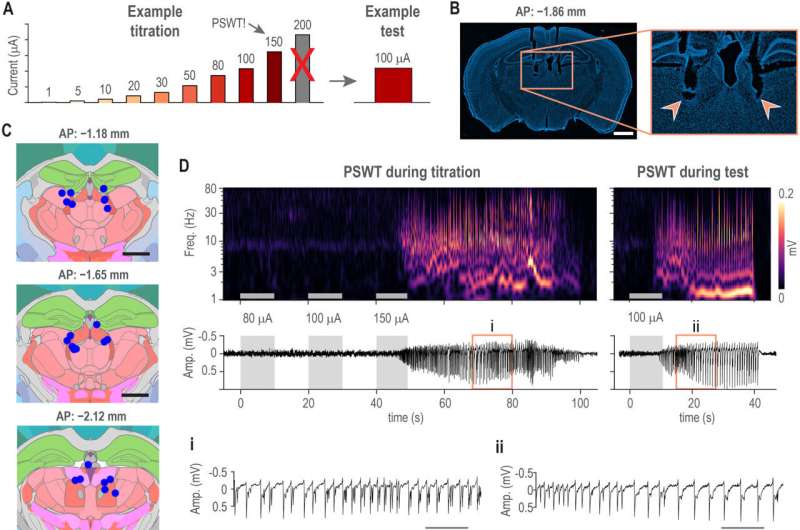This article has been reviewed according to Science X's editorial process and policies. Editors have highlighted the following attributes while ensuring the content's credibility:
fact-checked
trusted source
proofread
Study quantifies seizure risk from stimulating thalamus in awake mice

The idea of electrically stimulating a brain region called the central thalamus has gained traction among researchers and clinicians because it can help arouse subjects from unconscious states induced by traumatic brain injury or anesthesia, and can boost cognition and performance in awake animals. But the method, called CT-DBS, can have a side effect: seizures.
A new study by researchers at MIT and Massachusetts General Hospital (MGH), who tested the method in awake mice, quantifies the probability of seizures at different stimulation currents and cautions that they sometimes occur even at low levels. The work appears in Brain Stimulation.
"Understanding production and prevalence of this type of seizure activity is important because brain stimulation-based therapies are becoming more widely used," said co-senior author Emery N. Brown.
In the brain, the seizures associated with CT-DBS occur as "electrographic seizures," which are bursts of voltage among neurons across a broad spectrum of frequencies. Behaviorally, they manifest as "absence seizures" in which the subject appears to take on a blank stare and freezes for about 10–20 seconds.
In their study, the researchers were hoping to determine a CT-DBS stimulation current— in a clinically relevant range of under 200 microamps—below which seizures could be reliably avoided.
In search of that ideal current, they developed a protocol of starting brief bouts of CT-DBS at 1 microamp and then incrementally ramping the current up to 200 microamps until they found a threshold where an electrographic seizure occurred. Once they found that threshold, then they tested a longer bout of stimulation at the next lowest current level in hopes that an electrographic seizure wouldn't occur. They did this for a variety of different stimulation frequencies.
To their surprise, electrographic seizures still occurred 2.2% of the time during those longer stimulation trials (i.e. 22 times out of 996 tests) and in 10 out of 12 mice. At just 20 microamps, mice still experienced seizures in 3 out of 244 tests, a 1.2% rate.
"This is something that we needed to report because this was really surprising," said co-lead author Francisco Flores, a research affiliate in The Picower Institute and CBMM, and an instructor in anesthesiology at MGH, where Brown is also an anesthesiologist. Isabella Dalla Betta, a technical associate at The Picower Institute, co-led the study.
Stimulation frequency didn't matter for seizure risk, but the rate of electrographic seizures increased as the current level increased. For instance, it happened in 5 out of 190 tests at 50 microamps, and 2 out of 65 tests at 100 microamps. The researchers also found that when an electrographic seizure occurred, it did so more quickly at higher currents than at lower levels.
Finally, they also saw that seizures happened more quickly if they stimulated the thalamus on both sides of the brain vs. just one side. Some mice exhibited behaviors similar to absence seizure, though others became hyperactive.
It is not clear why some mice experienced electrographic seizures at just 20 microamps while two mice did not experience the seizures even at 200. Flores speculated that there may be different brain states that change the predisposition to seizures amid stimulation of the thalamus.
Notably, seizures are not typically observed in humans who receive CT-DBS while in a minimally conscious state after a traumatic brain injury or in animals who are under anesthesia. Flores said the next stage of the research would aim to discern what the relevant brain states may be.
In the meantime, the study authors wrote, "EEG should be closely monitored for electrographic seizures when performing CT-DBS, especially in awake subjects."
The paper's co-senior author is Matt Wilson, Sherman Fairchild Professor at The Picower Institute, CBMM, and the departments of Biology and Brain and Cognitive Sciences. In addition to Dalla Betta, Flores, Brown and Wilson, the study's other authors are John Tauber, David Schreier, and Emily Stephen.
More information: Flores, F. J. et al. Electrographic seizures during low-current thalamic deep brain stimulation in mice, Brain Stimulation (2024). DOI: 10.1016/j.brs.2024.08.002. linkinghub.elsevier.com/retrie … ii/S1935861X24001396


















